There’s a bumper sticker you see up north that reads “Alaska Girls Kick Ass,” and the eight women profiled here give a sense of the flinty resilience that comes from living in such an untamed place. Whether they’re descended from generations of Alaska Natives or relatively recent arrivals from “the outside,” they show true grit and endurance, serving their communities, helping to preserve the environment, and ultimately defining what attracts us all to the wildest place in America.
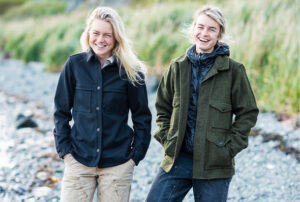
The Fishers
Emma Teal Laukitis and Claire Neaton
Emma Teal Laukitis has been up since 4 a.m., pulling shimmering chum salmon from the gillnet on the F/V Acadian, in the Copper River fishery. Her sister, Claire Neaton, is 70 miles away, aboard a tender for the salmon seine fleet in Prince William Sound. Across this distance, the Salmon Sisters, as they’re called, are working to ship more than 4,000 boxes of flash-frozen wild halibut, sablefish, Pacific cod, and salmon throughout the U.S. each year.
The sisters, who were born on a subsistence homestead 650 miles southwest of Anchorage, have been fishing since the age of 12 or 13, when they started working on their family’s boat, The Lucky Dove, out of False Pass. They both went to college on the East Coast, returning each summer to fish. They came back permanently after graduation, and while commercial fishing is a tough industry, both saw potential.
“We wanted to go back to Alaska,” Laukitis says, “and we could see that with some work we could build our little family business into a much bigger one.”
One way to do this was to diversify. In 2013, Laukitis created a line of Salmon Sisters clothing screenprinted with her ocean-inspired designs. Soon after, Xtratuf, which makes rubber boots that are ubiquitous in Alaska, invited her to create a pattern for its boot lining. The biggest break, which extricated them from the costs of working with middlemen, came in 2020, when the women purchased a 4,000-square-foot processing plant near the city dock in Homer, allowing them to market and ship fish directly to consumers all over the country. (They’ve even published a cookbook, The Salmon Sisters: Feasting, Fishing, and Living in Alaska, with another due out next year.)
In addition to their business success, the Salmon Sisters are dedicated to their community and the environment. They donate at least 1 percent of their net profit to the Food Bank of Alaska, in the form of wild fish, and they are outspoken about protecting marine ecosystems and keeping commercial fishing sustainable.
“It’s all part of our mission to educate people on sustainability,” Laukitis says. “We’re not just about selling fish and gear. Making sure people understand what it takes to have safe, healthy, sustainable fisheries in Alaska—everywhere, really—is the biggest deal for us.”
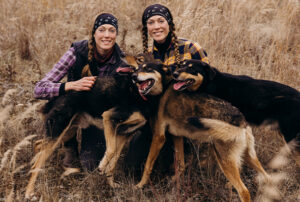
The Mushers
Anna and Kristy Berington
Alaska’s iconic Iditarod ran for the 50th time last month, and among the racers mushing their Alaskan Huskies 1,000 miles from Anchorage to Nome were identical twin sisters Anna and Kristy Berington.
“Why do we run the Iditarod?” asks Kristy, who has finished the grueling race 11 times, to her sister’s nine. “Because we love the dogs. They are tough, genuine adventure-seekers, just like we are. Mushing is primitive, and it takes a special breed of dog and type of human to join forces and embrace a lifestyle like this.”
The Wisconsin natives are born mushers: As kids, they harnessed their pet dogs to a sled they built from downhill skis and a plastic milk crate. In 2008, after high school and a stint in the National Guard, they went to work at sled-dog-racing star Dean Osmar’s kennel in Cook Inlet, Alaska. Ten years later, they established their own kennel, Seeing Double Sled Dog Racing, in the village of Knik, where they care for and train more than 40 dogs.
In the summer, the women do residential construction and landscaping jobs to help fund their operation, but as soon as there’s snow on the ground, it’s all dogs, all the time. They log over 3,000 miles in training runs with each dog before a major race, often camping out in brutally cold conditions.
“You have to be able to take care of yourself—you can’t depend on help from a guy,” Kristy says. “It’s not unusual to come around a corner and find a tree down in the middle of the trail. If you can’t stop fast enough, you’ll have a tangle—half the dogs under it and half over it. That’s when you get out your 22-inch axe and start chopping.”
While animal rights groups have raised concerns about the treatment of sled-racing dogs, the Beringtons insist they keep their pups safe. “Maybe because we’re women, we adopt a motherly role with the dogs,” Anna says. “When you’re out on the trail, you’re a coach, nutritionist, and physical therapist.” And best friend: “We’re all about love and connection.”
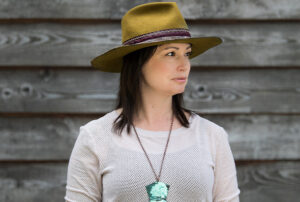
The Craftswoman
Jennifer Younger
Thump-thump goes the rawhide mallet against the copper and silver. Thump-thump, as Jennifer Younger shapes the materials—which she has already engraved with flowing, curvilinear lines in the style of the Alaska Native Tlingit, Haida, and Tsimshian tribes—into a cuff bracelet in her Sitka studio.
While Younger’s work is decidedly modern and high-end—her one-of-a-kind pieces can go for up to $2,800 at her online shop or one of the galleries around the world that represent her, including the Steinbrueck Native Gallery in Seattle—her aesthetic is rooted in formline, a technique imbued with spiritual significance that’s more than 2,000 years old.
“This work allows me to be creative, while at the same time embracing my heritage,” says the artist, whose grandmother was Tlingit and grandfather was of European descent. “It’s a way to honor my past and the natural world.”
Younger grew up on the edge of the southeast Alaska town of Yakutat without running water or electricity, spending her days on the beach and in the woods, exposed to the beauties of nature that she’d eventually incorporate into her work. She learned to engrave in form-line through an apprenticeship with Alaska Native artist Nicholas Galanin, and while she was reluctant to experiment within the traditional medium, Galanin’s father, also a carver and engraver, encouraged her to develop new designs based on the classic shapes. Soon, she found her métier, incorporating spruce root weaving, another Native art tradition, to give her pieces a dramatic, contemporary look.
Aside from the chance to do something she loves, Younger’s work gives her an opportunity to be an advocate for her fellow Alaskan artists. “Through sharing my art with the world, I want to bring light to the Northwest Coast indigenous art form,” she says, “and have that light shine on the multitude of amazing artists from my region.”

The Illustrator
Michaela Goade
Pans of watercolor and gouache and stacks of rough textured paper surround Michaela Goade in her studio in Sitka. She builds layer upon layer of color as she paints, conjuring streaming ribbons of gray, blue, and green water.
“I like being able to make a mess, feel the paint,” she says. “I love the opportunity to embrace the imperfections, let all those marks be visible.”
Of mixed Tlingit and European heritage, Goade grew up in Juneau, surrounded by the waterways, rain forests, mountains, and meadows that influence her palette today. A former graphic designer and art director, she began doing illustrations for children’s books as a freelancer, and one of those, Shanyaak’utlaax: Salmon Boy, won the 2018 American Indian Youth Literature Award for Best Picture Book. She would soon take home an even bigger prize: Last year, she became the first BIPOC woman to receive the Caldecott Medal, given annually to the artist of the most distinguished American picture book for children, for We Are Water Protectors.
Written by Carole Lindstrom, an enrolled member of the Turtle Mountain Band of Ojibwe Indians, We Are Water Protectors features a young indigenous girl as its protagonist, and it uses the Anishinaabe prophecy that a black snake will ruin the water’s purity and poison the land as a metaphor for the construction of the controversial Dakota Access Pipeline. The message certainly hit home, as it topped the New York Times Children’s Picture Books best-seller list.
“It’s amazing that it has reached as far as it has and has resonated with so many people,” Goade says. “I feel so grateful to be able to create respectful and accurate representations of indigenous people in children’s literature. Books like this, that make indigenous children feel seen and empowered, didn’t exist when I was a kid.”
Goade is now taking the next literary step. This summer, she makes her debut as an author with Berry Song, which follows a young Tlingit girl and her grandmother as they gather wild berries through the seasons in southeast Alaska. “With this work,” Goade says, “comes enormous responsibility.”
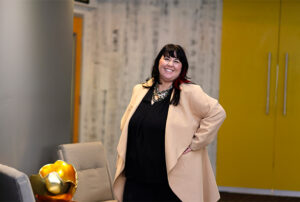
The Designer
Michael Fredericks
Michael Fredericks possesses an infectious smile and is quick to laugh, but that doesn’t mean she’s not serious. As president of Anchorage-based SALT, Alaska’s largest full-service commercial interior design firm, she is often called upon to help resolve intractable problems, a process that frequently includes working as a liaison between corporate and Native leaders.
“As a facilitator and a strategist, one of my jobs is to help Native people, who have historically not had a voice, become involved in planning, in visioning,” she says.
Fredericks is suited to the job. An Alaska Native of Yup`ik descent, she grew up in Anchorage, the daughter of a tribal council president who ran a construction company. “Because of him,” she says, “I started with a certain amount of knowledge of how tribes work and the structure of Native government and business.” She has also experienced firsthand how it feels to be marginalized: “My dad spent much of his time meeting with senators in D.C. about tribal business, but we were still shooed out of Anchorage department stores when I was a child, because they assumed that this respected executive was a drunk Native.”
Fredericks studied at the University of Washington and the University of Illinois Chicago, but her focus always remained on what she could do for Alaska Native people. In 2001, she came to work at Anchorage’s RIM Architects and RIM Design, and by 2018 she had taken over as president of what is now SALT. Among the firm’s current projects is a second building for Covenant House Alaska, which provides housing for youth facing homelessness. The first structure was so successful that the collaborative design process—a hallmark of Fredericks’ approach—became a model for Covenant facilities nationwide. “From the beginning, we involved the community, the staff, the youth, the volunteers,” she says. “We had a kid from Covenant on the design team as an intern.”
SALT is also strategizing with Emily Edenshaw, the president and CEO of the Alaska Native Heritage Center in Anchorage, on plans to bring that facility up to date in a way that’s interactive and immersive. “The cultures celebrated there are very much alive,” Fredericks says, “and it’s up to us to convey that excitement.”
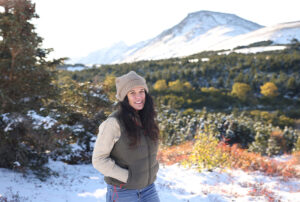
The Chef
Laura Cole
In the past 24 hours, Laura Cole has completed the 500-mile round-trip from the edge of Denali National Park & Preserve to Anchorage, a drive she makes weekly, no matter the weather, to stock up on supplies for her restaurant, 229 Parks. Still, it’s 10 a.m. and she’s in the kitchen, cooking mussels and steaming artichokes. “We do everything from scratch, with a team of six,” she says. “After I finish here, I have to mow the lawn.”
While Cole’s attitude may be humble, her cuisine is anything but: The James Beard Foundation has nominated her for Best Chef: Northwest five times. Her menu on any given night might include reindeer liver pâté or handmade tangerine semolina noodles in morel mushroom tea. “We really want to represent Alaska in each dish,” she says, “so one of the key flavor factors or components has to come from here, whether it’s foraged, ranched, farmed, or fished.”
Despite her affinity for local fare, Cole isn’t a native of Alaska. Raised in the suburbs of Detroit, she attended the University of Michigan-Dearborn, and one summer followed her future husband to Alaska to cook at his parents’ wilderness lodge. She didn’t intend to make the Last Frontier home, but she’d fallen in love. “It’s a common story—we come for the guys,” she says with a wry grin. “The guys don’t stay, or the relationship falls apart, but by then we’re in love with the life and the community, and we aren’t leaving.”
She and her now ex-husband opened 229 Parks in 2005, and over the years it has become more than just a place to have a meal. The dining room is decked with works by Alaska-based artists, and upstairs there’s a ping-pong table and a cozy place for live music. “It’s a living room for the community,” Cole says, noting that several thousand people live in the nearby town of Healy, and hers is the only restaurant open year-round, other than a diner, for 150 miles. “People come with their families in the winter, when they have to get out of the house.” The vibe she has created embodies one of her favorite expressions: “Small town, so good.”




